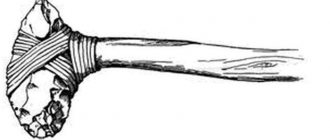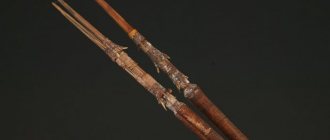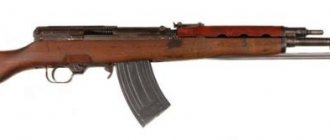likeforyou2.ru
From time immemorial, wars for territory have occupied most of the lives of people, especially men. Even animals tend to protect their territory. Each man was a breadwinner and protector of his home, his family, his tribe. Even ancient people adapted what nature provided into tools for hunting, defense and work.
Different peoples had their own national clothes and weapons. In ancient times, to create tools, they used what they could find at hand - various stones, sticks, ropes. With the advent of blacksmithing, swords, armor, and shields began to appear. Over the years, weapons have undergone changes and improvements.
Druzhina
The Slavs were a peace-loving people, so the ancient Russian warriors did not stand out too much from the background of ordinary peasants. They defended their home with spears, axes, knives and clubs. Military equipment and weapons appear gradually, and they are more focused on protecting their owner than on attack. In the 10th century, several Slavic tribes united around the Prince of Kyiv, who collected taxes and protected the territory under his control from the invasion of the steppes, Swedes, Byzantines, and Mongols. A squad is formed, 30% of which consists of professional military men (often mercenaries: Varangians, Pechenegs, Germans, Hungarians) and militias (voi). During this period, the weapons of the ancient Russian warrior consisted of a club, a spear, and a sword. Lightweight protection does not restrict movement and ensures mobility in battle and on the march. The main branch of the army was infantry; horses were used as pack animals and for delivering soldiers to battlefields. The cavalry is formed after unsuccessful clashes with the steppe people, who were excellent riders.
Types of troops
In Ancient Rus' there were three types of troops: infantry, cavalry, and navy. Initially, infantry troops appeared. The bulk of them are “voi”. Already under Prince Svyatoslav Igorevich, soldiers used pack horses instead of convoys. This accelerated the movement of the army. The infantry took part in the capture of cities and covered the rear. Carried out different types of work: engineering or transport in nature.
Later cavalry appeared, but the mounted troops were few in number. In the tenth century, they preferred to fight on foot, and gradually the warriors became more and more sophisticated. The cavalry helped repel the attacks of the nomads. Since the 11th century it has occupied an important place, becoming on a par with infantry, and later superior to foot troops. The cavalry, like the infantry, had heavily armed warriors. These are defenders with swords, sabers, axes, and maces. Fast, lightly armed warriors also stood out. They were armed with a bow and arrows, an iron mace or battle axes. Only infantry troops used heavy weapons and mortars.
The fleet played an important, but not a key role. It was used only on large sea voyages. In the ninth century in Rus' there were flotillas, which included up to two thousand ships. Their main role was transport; soldiers were transported on ships. But there were also special military ships designed for combat. The warriors were transported on boats, which could accommodate up to 50 people. Later, the boats were equipped with throwing machines and rams. Decks intended for archers were built on them.
Berserkers
These are warriors who could consciously cause a battle frenzy. The wolf-knights showed spiritual strength due to the fact that they dedicated their lives to the god Odin. Usually berserkers stood in front of ordinary warriors and began the battle. They were not on the field for long while the trance state continued. Afterwards they left the battle, and the remaining warriors completed the battle.
In order to become a knight, it was necessary to defeat an animal with bare hands: a bear or a wolf. After the victory, the warrior became a berserker, everyone was afraid of him. Such a warrior cannot be defeated, because the spirit of the animal lives in him. The berserker dealt 3 - 4 blows to defeat the enemy. The knight had an instant reaction, several steps ahead of an ordinary warrior. In many ancient texts, berserkers are called werewolves.
Protection
Old Russian wars wore shirts and ports, common for the population of Rus' in the 5th - 6th centuries, and put on bast shoes. During the Russian-Byzantine war, the enemy was amazed by the courage and bravery of the “Rus”, who fought without protective armor, covering themselves with shields and using them at the same time as weapons. Later, the “kuyak” appeared, which was essentially a sleeveless shirt, it was trimmed with plates from horse hooves or pieces of leather. Later, metal plates began to be used to protect the body from slashing blows and enemy arrows.
Shield
The armor of the ancient Russian warrior was light, which ensured high maneuverability, but at the same time reduced the degree of protection. Large, human-sized wooden shields have been used by Slavic peoples since ancient times. They covered the warrior's head, so in the upper part they had a hole for the eyes. Since the 10th century, shields have been made in a round shape, they are covered with iron, covered with leather and decorated with various family symbols. According to the testimony of Byzantine historians, the Russians created a wall of shields that tightly closed with each other, and put spears forward. This tactic did not allow the advanced units of the enemy to break through to the rear of the Russian troops. After 100 years, the uniform is adapted to a new type of army - cavalry. The shields become almond-shaped and have two mounts designed to be held in battle and on the march. With this type of equipment, ancient Russian warriors went on campaigns and defended their own lands before the invention of firearms. Many traditions and legends are associated with shields. Some of them are still “winged” to this day. Fallen and wounded soldiers were brought home on shields; when fleeing, the retreating regiments threw them under the feet of the pursuers' horses. Prince Oleg hangs a shield on the gates of the defeated Constantinople.
Voivode strategy and tactics
The Kyiv princes rarely split up their army and consistently attacked their opponents with all their might. Although there were known cases when warriors of Ancient Rus' fought on several fronts at the same time. In medieval times, troops were divided into parts.
The main tactical maneuver of the infantry was the "wall". But this was possible in the 9th - 10th centuries, when the cavalry was poorly developed and small in number. The army was lined up in even rows of 10–12 ranks. The first warriors put their weapons forward and covered themselves with shields. Thus, they walked in a dense “wall” towards the enemy. The flanks were covered by cavalry.
The second tactical maneuver was the wedge. The warriors lined up in a sharp wedge and rammed the enemy wall. But this method revealed many shortcomings, since the enemy’s cavalry entered from the rear and phalanxes and hit vulnerable areas.
The cavalry performed tactical maneuvers, depending on the course of the battle. The warriors pursued the fleeing troops, launched counter strikes or went out on reconnaissance. The horsemen made a roundabout maneuver to strike at the poorly protected enemy forces.
Helmets
Old Russian warriors, until the 9th – 10th centuries, wore ordinary hats on their heads, which did not protect them from the chopping blows of the enemy. The first helmets found by archaeologists were made according to the Norman type, but they were not widely used in Rus'. The conical shape has become more practical and therefore widely used. In this case, the helmet was riveted from four metal plates; they were decorated with precious stones and feathers (for noble warriors or governors). This shape allowed the sword to slip without causing much harm to the person; a balaclava made of leather or felt softened the blow. The helmet was changed due to additional protective devices: aventail (chain mail mesh), nasal (metal plate). The use of protection in the form of masks (faces) was rare in Rus'; most often these were captured helmets, which were widely used in European countries. The description of the ancient Russian warrior, preserved in the chronicles, suggests that they did not hide their faces, but could fetter the enemy with a menacing gaze. Helmets with a half mask were made for noble and wealthy warriors; they were characterized by decorative details that did not have a protective function.
Russian squads in battle. Part 5
Defensive weapons
All armor, helmets, bracers, leggings, and shields are designated by the general term “defensive weapons.” Defensive weapons have been known to people since ancient times. Based on the examples of primitive tribes that were able to survive until the 20th and even the beginning of the 21st centuries, we know that the ancient people knew protective weapons. These are the simplest wooden shields, and the first armor made of leather, wooden or bone plates. As soon as people became familiar with metal, not only offensive but also defensive weapons began to be made from the new material.
In the 9th – 10th centuries. a complete set of iron defensive weapons was expensive and rare. Later, as craft production developed, armor became a more widespread phenomenon. However, even then, full-fledged defensive weapons remained mainly the property of the military elite - princes, boyars and their warriors. The main type of defensive weapon of a simple militia remained a wooden shield. But as handicraft production grew in the cities, the percentage of heavily armed soldiers in the Russian army constantly grew.
Chain mail.
This type of defensive weapon appeared back in the 1st millennium BC. e. and was known in the Middle East and the Roman Empire. For quite a long time it was believed that with the fall of Rome, chain mail was forgotten in Western Europe and was re-adopted only during the Crusades, when knights saw its advantages during the wars with Muslims. However, it later turned out that this opinion was wrong. Ringed armor was widely known in the early Middle Ages in the territory of Great Scythia - Sarmatia, from the Carpathians to the North Caucasus, the Kama region and the Urals. Chain mail was also common in “barbarian” Europe, including Scandinavia.
Early chain mail looked like a short shirt with sleeves (up to 70 cm long), which usually reached the elbows. The collar slit was located in the middle of the neck or was shifted to the side, the collar reached 10 cm. The outer diameter of its rings reached 10-11 mm. The advantage of ancient Russian chain mail was its relative lightness and flexibility. It did not restrict the warrior’s movements, and at the same time it was good protection. Average weight of Russian short chain mail X – XIII centuries. was about 6-7 kg.
1. Russian chain mail. IX–XIII centuries. 2. Weaving elements made of one riveted and four welded rings. Source: We are Slavs! Encyclopedia.
Eastern Slavs in the 8th – 10th centuries. They made chain mail themselves. Apparently, having become heirs to the traditions of the Sarmatian-Alan era. Chain mail made by Russian craftsmen of the 10th century reached distant Khorezm through Volga Bulgaria. After some time, Russian chain mail received recognition in Western Europe. On the territory of Rus', archaeologists have found more than a hundred chain mail of the 9th – 13th centuries. of which about 40 are whole. “Ringed armor” (the word “chain mail” was first recorded in written sources of the 16th century) was made by craftsmen from approximately 20 thousand rings 6 – 13 in diameter, with a wire thickness of 0.8 – 2 mm. To make just one such “shirt”, about 600 m of wire was required. When using another technology, the rings were not made from wire, but were cut out of a sheet of iron using a special stamp. The rings were usually of the same diameter. But in later times, they began to combine rings of different sizes, covering the most important parts of the body with small weaving. Some rings were welded tightly. Every four such rings were connected by one open ring, which was then riveted. Before Batu’s invasion, chain mail made of flattened links – “baidans” and chain mail stockings – “nagavitsy” appeared in Rus'.
A horseman in chain mail and caps.
1. Rings of chain mail. VIII–XIII centuries. 2. Weaving from welded and riveted rings.
Carapace (plate armor).
For a long time it was believed that the Russians became acquainted with plate armor - “plank armor” no earlier than the 12th century. However, pictorial sources have brought to us images of armor, which, as a rule, are shown in the form of scales. And in the chronicle story about how in 968 the Pechenegs first came to Russian land, it is reported that governor Pretich exchanged gifts with the Pecheneg prince and among the Russian gifts was armor. In 1948, steel plates were found in a layer of the 11th century in Novgorod. These were fragments of plate armor. Soon similar finds were made in other ancient Russian cities. In IX – XII, chain mail predominated in the protective equipment of Russian soldiers. For approximately every four pieces of chain mail found, there are fragments of just one shell. In the XII – XIII centuries. with the development of offensive and defensive weapons, chain mail began to give way to plate armor. So, in the same Veliky Novgorod in the layers of the XIV - XV centuries. There is already one piece of chain mail for every nine remnants of plate armor. The conquerors must have used the same plate armor.
Lamellar armor, like chain mail, is a legacy of a more ancient era. It was known in the Middle East as early as 2 thousand BC. e. and armor of this type was widespread throughout Eurasia, including the Scythian-Siberian world and the Far East. In Rus', “plank armor” has been known since the formation of the Rurik Empire and is another legacy of Scythia.
I. Warriors in lamellar and scaly armor. From the stamps of the hagiographic icon “St. George”. Beginning of the 14th century. II. Details of protective clothing (VIII-XIV centuries): 1 – details of plate armor, 2 – fastening parts of plate armor, 3 – fastening scale armor, 4 – details of scale armor.
The shell is an armor assembled from small plates (it is also called lamellar). The armor plates were tied together with straps passed through small holes along the edges of the plates. The plates overlapped one after the other, so the impression of scales was created, and in the places where the plates overlapped, the protection was double. In addition, the plates were made curved, which was supposed to better remove or soften impacts.
The most ancient system, which lasted for a very long time on the territory of Rus', did not require a leather base. Elongated rectangular metal plates measuring 8 (10) x 1.5 (3.5) cm were tied together using straps. Judging by pictorial sources, such a shell reached the hips and was divided in height into horizontal rows of closely compressed plates.
Another type of armor was scale armor. The plates were almost square - 6 x 4 (6) cm, and were laced to a leather or thick fabric base. The plates were moving towards each other. This shell contained 600–650 plates. To prevent the plates from becoming brittle from impact or sudden movement and from moving away from the base, they were also fastened to the base with one more - two central rivets. This shell, in contrast to the “belt weaving” system, was more plastic. Plates of scaly shells were found in layers of the 13th – 14th centuries. Scale armor has been seen in drawings since the 11th century.
In addition, combined armor existed in Rus'. For example, chainmail on the chest, and scaly on the sleeves and hem. Very early in Rus' other protective elements appeared - bracers, elbow pads and leggings. Bracers protected the warrior’s arm from hand to elbow. One such bracer was found during excavations of the southern Russian settlement of Sakhnovka. The bracer from Sakhnovka was double-leaf - a long rounded flap covered the warrior’s hand from the outside, a short rectangular one protected the wrist. The bracer was attached to the hand using straps.
Warrior in combined armor.
Helmet.
Shlemov VI – VIII centuries. Archaeologists have not yet discovered it in Eastern Europe. One of the oldest - a conical helmet was found in a mound of the 10th century. An ancient blacksmith forged it in two parts and connected it with a strip and a double row of rivets. The lower edge was covered with a hoop, which had loops for the aventail - a chainmail mesh that covered the neck and head from the back and sides. The scientific world of the 19th century hastened to call the helmet Scandinavian (“Norman”). It soon became clear that such helmets were widespread over a large area. The Scandinavians used other types of helmets. Conical helmets were of eastern origin.
However, conical helmets did not become widespread in Rus'. Sphero-conical helmets, which better deflected blows, also date back to the 10th century. These helmets were usually made from several, most often four, plates 1.2-1.7 mm thick, which were placed on top of each other and connected with rivets. At the bottom of the helmet, using a rod that was inserted into the loops, the aventail was attached. Most helmets of this type clearly did not belong to ordinary warriors. The iron plates are figuratively carved and covered with gold and silver. The elongated top of the helmet sometimes ended with a bushing for a plume for feathers or dyed horsehair.
Conical, sphero-conical and domed helmets of the 10th–13th centuries.
Another type of helmet that was common in Rus' in the 11th – 13th centuries. - These are tall “bell-shaped” sphero-conical helmets with circles for the eyes and nosepieces. This helmet is very popular among artists depicting ancient Russian warriors. In addition, in the lands of the “black hoods” they wore tetrahedral helmets with platbands - masks that covered the entire face. Such helmets appeared in the 12th century.
Bell-shaped sphero-conical helmets with hollows for the eyes and nosepieces. XI–XIII centuries.
Helmet with a mask. XIII century.
Bigwigs.
Helmet with half mask, nose guard and eye circles. XII–XIII centuries.
The spherical-conical helmets of the Old Russian state gave rise to the later Moscow “shishak”. At the turn of the 12th-13th centuries, a type of steep-sided dome-shaped helmet with a half-mask - circles for the eyes and a nosepiece - was developed. We must not forget some important details of ancient Russian helmets. This is a soft lining, it was usually made of fur, it was needed for comfort - it is not very pleasant to put an iron object directly on the head, and to soften the blows of the enemy. The helmets were equipped with straps for fastening under the chin. Otherwise, the helmet could simply fly off the head from a sudden movement, not to mention a blow in battle.
Helmet from the Black Grave mound, 10th century.
Russian shelom of the 16th century.
Shield.
They like to depict Slavic warriors armed with almond-shaped shields. However, this is a mistake. Archaeological data indicate that in the VIII - X centuries. The Rus, like their neighbors, had round shields, usually a meter in diameter. Archaeologists have found that the oldest shields were flat and consisted of several wooden planks - about 1.5 cm thick, which were joined together, covered with leather and fastened with rivets. On the outer surface of the shield, especially along the edge, there were iron fittings. There was a hole in the middle of the shield, which was covered by a convex metal plaque, which was used to reflect the blow (“umbon”). The umbons had a hemispherical and sphero-conical shape.
On the inside of the shield there were straps, into which the warrior threaded his hand. There was also a strong wooden strip that served as a handle. There was also a belt over the shoulder; it was needed so that the warrior could throw the shield behind his back, during a campaign, or when he had to act with both hands.
Round shield with umbo and basic forms of umbos. IX–X centuries.
In the 11th century, the shields became convex. At the same time, almond-shaped shields spread en masse. But round shields are not giving up their positions. Almond-shaped shields were widely distributed throughout Europe. Apparently, this was due to the strengthening of the role of cavalry. The almond-shaped shield covered the mounted warrior from shoulder to knee and was more convenient for him than the round one. The height of the almond-shaped shield ranged from a third to half of human height. These shields were flat or slightly curved along the longitudinal axis. The height to width ratio was 2:1. Almond-shaped shields, like round ones, were made of wood and leather, bound at the edges and had a umbon.
Shields were usually painted and decorated. In the 12th century these were emblems and symbols of princely families. In the images of holy warriors, the shields were decorated with crosses. In an earlier era, shields were apparently decorated with sacred symbols, signs of clan and tribe. The background of the shield was colored. It is known that the Russians preferred the color red.
In Ancient Rus', the shield was a prestigious type of weapon. Early sources mention the shield in third place, immediately after the sword and spear. Suffice it to remember that among the pagan Slavs the Sun itself (Dazhdbog Svarozhich) was a fiery golden shield. The Prophetic Oleg hung his shield on the gates of Constantinople as a sign of patronage. The Russians swore by shields and sealed contracts. The dignity of the shield was protected by Russian Truth - a person who dared to steal the shield or damage it had to pay a significant fine. The loss of a shield in battle was a symbol of complete defeat and defeat.
The inner side of the round shield and its side view. XII–XIII centuries
Almond-shaped shield and its side view. XI – early XIII century
Warrior clothing
Fabric and leather are poorly preserved in the ground; this requires special conditions, such as the swamps of the Novgorod land, which preserved many objects of ancient Russian life. There are also few images of ancient Rus. Metal objects are better preserved - weapons, some parts of clothing, such as buckles, buttons and brooches (clasps of cloaks and shirts). Using some of these details, scientists reconstruct the general appearance of clothing. In addition, researchers, due to a lack of sources, often turn to materials from neighboring peoples - the inhabitants of Scandinavia or the Steppe. Later Russian ethnographic materials - from the 18th - early 20th centuries - are also attractive; fortunately, traditions in clothing have been preserved until this time.
The set of men's clothing included a shirt, trousers and a cloak. They wore leather shoes on their feet and hemispherical hats with fur bands on their heads. Clothes were made from linen and wool. In addition, expensive foreign silk was popular among the warriors.
Russian prince with his retinue. First half of the 11th century. Based on materials from archaeological finds in Kyiv, Chernigov and Voronezh region. Source: Warriors of the era of Ancient Rus' of the 10th - 11th centuries in drawings and reconstructions by Oleg Fedorov.
A mandatory part of the ancient Russian costume was a leather belt with metal parts. Archaeologists call the belts, which were decorated with plaques, inlaid. The heyday of Russian typesetting belts began in the 10th century. However, even later they did not go out of use. In particular, belts with precious metals are mentioned in princely spiritual charters (wills) of the 14th – 15th centuries. Such a belt was a symbol of the warrior’s high position in society. Sometimes in burials there are complex belts with several types of plaques, the total number of which can reach several dozen. Belt plaques come in various shapes and have different patterns: trefoils, crin-lilies, geometric figures, floral curls, etc. Knives and small bags decorated with plaques or chased plates were hung from the belt. Typically, such handbags were small - 12 - 14 cm in length and width.
The pants were like harem pants. The wearing of such trousers by the Slavs - wide, gathered at the knee - is mentioned by the Eastern scientist of the early 10th century, Ibn Ruste. Such wide trousers were convenient for riding.
There is practically no data on shoes. Apparently, Russian soldiers wore leather ankle boots and boots typical of that era. In inclement weather and in winter, horseshoes in the form of shoe spikes were worn on shoes. Early boots had a low straight boot made of two halves - front and back. Later, more complex boots appeared - with a boot that widened upward and was cut from several parts. The toe was pointed, and the sole was made multi-layered. In the 14th century, the boot had a small heel.
They wore a “Russian fur hat” on their heads, known from the Scandinavian sagas. Perhaps it was cap-shaped with a fur trim; such hats were widespread in the steppe zone. Apparently, this hat is described by eastern authors: “They (Russians - author) tend to wear woolen hats with the tail hanging down the back of the head.” And Ibn Fablan mentions a brocade hat trimmed with sable.
Little is known about ancient Russian cloaks, outer clothing that protected a person from bad weather. The shape of the cloak is reconstructed from extant images of princes on book miniatures, coins, and seals. It was close to a semicircle, or a sector of a circle of approximately 140-160 degrees. It is possible that an undercut was made on one side (a small triangular section of fabric was cut out, and then the edges of the cut were sewn together), thanks to which the cloak fit tightly around the shoulders. The cloak was fastened with a special fastener - a fibula, which was located on the chest or side, under the right arm.
The costume of a Russian warrior included a caftan. This swinging clothing, convenient for a horseman, has been widespread since ancient times from the Middle East to the steppe zone of Eurasia. Kaftans in Rus' in the 10th century are found precisely in the monuments of Russian druzhina culture - the burial mounds of Gnezdov, Timerev, and burial grounds near Chernigov. The closest relatives of Russian caftans are Alan caftans. Alan caftans, depending on the wealth of the owner, were made of silk or linen. Some caftans were lined with fur. Russian caftans, given the more severe climatic conditions, were apparently made of wool. This is confirmed by a find in one of the Gnezdov mounds - the top of the caftan was wool, and the lining was leather.
Kyiv warrior of the 10th century. Based on materials from M.K. Karger’s excavations of the Tithe Church of Kyiv.
A noble warrior of the Rus squad. The end of the 10th - beginning of the 11th century. Based on materials from the burials of the Shestovitsy burial ground, Chernigov region.
Old Russian warrior. Second half of the 10th century. Based on materials from T.A. Pushkina, Smolensk region, Gnezdovo archaeological complex.
An ancient Russian warrior in a swinging caftan made of printed fabric. Second half of the 10th century. Based on materials from T.A. Pushkina, Smolensk region, Gnezdovo archaeological complex, burial Dn-4.
To be continued…
Chain mail
The most famous part of the vestment of the ancient Russian warrior, according to archaeological excavations, appears in the 7th - 8th centuries. Chain mail is a shirt made of metal rings tightly connected to each other. At this time, it was quite difficult for craftsmen to make such protection; the work was delicate and took a long period of time. The metal was rolled into wire, from which rings were rolled and welded, fastened to each other according to a 1 to 4 pattern. At least 20 - 25 thousand rings were spent on creating one chain mail, the weight of which ranged from 6 to 16 kilograms. Copper links were woven into the fabric for decoration. In the 12th century, stamping technology was used, when woven rings were flattened, which provided a larger area of protection. During the same period, chain mail became longer, additional elements of armor appeared: nagovitsa (iron, wicker stockings), aventail (mesh to protect the neck), bracers (metal gloves). Quilted clothing was worn under the chain mail to soften the force of the blow. At the same time, lamellar (plate) armor was used in Rus'. For manufacturing, a base (shirt) of leather was required, onto which thin iron slats were tightly attached. Their length was 6 - 9 centimeters, width from 1 to 3. Lamellar armor gradually replaced chain mail and was even sold to other countries. In Rus', scale, lamellar and chain mail armor were often combined. Yushman, bakhterets were essentially chain mail, which, to increase their protective properties, were equipped with plates on the chest. At the beginning of the 14th century, a new type of armor appeared - mirrors. Large metal plates, polished to a shine, were usually worn over chain mail. They were connected on the sides and shoulders with leather straps and were often decorated with various kinds of symbols.
Weapon
The protective clothing of the ancient Russian warrior was not impenetrable armor, but was distinguished by its lightness, which ensured greater maneuverability of warriors and shooters in battle conditions. According to information obtained from historical sources of the Byzantines, the “Rusichi” were distinguished by enormous physical strength. In the 5th – 6th centuries, the weapons of our ancestors were quite primitive, used for close combat. To cause significant damage to the enemy, it had a lot of weight and was additionally equipped with damaging elements. The evolution of weapons took place against the backdrop of technological progress and changes in combat strategy. Throwing systems, siege engines, piercing and cutting iron tools were used for many centuries, and their design was constantly improved. Some innovations were adopted from other nations, but Russian inventors and gunsmiths have always been distinguished by the originality of their approach and the reliability of the manufactured systems.
Clothing of an ancient Russian warrior.
It is difficult to say with 100% certainty how the ancient Russian warrior dressed; photographs had not yet been taken in those days. It remains to judge only by the chronicles and paintings of artists. Although the governors were revered people, they were still people. They needed, like everyone else, to eat, sleep, and rest. They couldn’t always be in armor and full uniform. Photos of Slavic warriors very rarely illustrate to us what these valiant men looked like in everyday life, at a feast or while relaxing with their family. But they did not go in their armor to the feast and to the world. For the people of Ancient Rus', the importance of clothing was overestimated; in addition to protection from natural conditions, clothing served as protection from evil spirits. What a person wore almost entirely determined his status. The style of suits and dresses of the nobility was no different from the style of clothing of commoners, the difference was only in the quality of materials and decorations. The Slavic warrior, pictures of whom can be found in history textbooks, judging by the images on them, has no differences in clothing from ordinary people, outside the field and outside the time of military operations.
Photo from the site likeforyou2.ru
Men of those years wore collarless wrap shirts that were belted at the waist. Under the armor, a cotton shirt made on a weaving loom was usually worn. The legs were covered with canvas trousers, the width of which resembled trousers, which were gathered at the waist and tied at the ankles and under the knees. Do you know what the ancient Russian warrior’s trousers, which were worn on the battlefield, were called? They were called trousers and protected the skin from hard armor. Now this word is outdated, and the number of varieties of pants has grown significantly. Boots made from a single piece of leather were put on the feet. It happened that the legs were wrapped in scraps of fabric, and a piece of leather was sewn to them as a sole. In fact, there was very little choice of what the ancient Russian warrior wore. Clothing was not his priority, the main thing was that it was comfortable and did not restrict movement, because he had more important tasks than choosing an outfit. In winter, hats elongated at the back and a caftan made of thick wool or natural fur were worn.
The clothing of modern people has undergone changes in appearance and began to be called differently. The names and clothing of the ancient Russian warrior also changed greatly. Few people now know obsolete words, and rarely anyone understands what they mean. You can give several examples of archaic words regarding the wardrobe of a Slavic warrior. Do you know what the clothes of the ancient Russian warrior were previously called? The names of those clothing items that are outdated? For example, a word such as greaves meant protection for the legs from piercing weapons. And as a protective headdress, they used a shishak or a hero, in reality it is an ordinary helmet. Words such as trousers or caftan are also not used in the modern world. But the boots have retained their name and relevance to this day.
Percussion
Weapons for close combat are known to all nations; at the dawn of the development of civilization, its main type was the club. This is a heavy club that is wrapped in iron at the end. Some options include metal spikes or nails. Most often in Russian chronicles, along with the club, the mace, shestoper, and flail are mentioned. Due to their ease of manufacture and effectiveness in combat, impact weapons were widely used. The sword and saber are partially replacing it, but militias and warriors continue to use it in battle. Based on chronicle sources and excavation data, historians have created a typical portrait of a man who was called an ancient Russian warrior. Photographs of reconstructions, as well as images of heroes that have survived to this day, necessarily contain some type of impact weapon, most often the legendary mace acts in this capacity.
Slashing, piercing
In the history of ancient Rus', the sword is of great importance. It is not only the main type of weapon, but also a symbol of princely power. The knives used were of several types; they were named according to the place where they were worn: boot knives, belt knives, side knives. They were used along with the sword and mace. The weapons of the ancient Russian warrior changed in the 10th century; the sword was replaced by a saber. The Russians appreciated its combat characteristics in battles with nomads, from whom they borrowed the uniform. Spears and spears are among the most ancient types of piercing weapons, which were successfully used by warriors as defensive and offensive weapons. When used in parallel, they evolved ambiguously. Rogatins are gradually being replaced by spears, which are being improved into sulitsa. Not only peasants (warriors and militias), but also the princely squad fought with axes. For mounted warriors, this type of weapon had a short handle, while infantrymen (warriors) used axes on long shafts. Berdysh (an ax with a wide blade) in the 13th – 14th centuries became a weapon of the Streltsy army. It later transforms into a halberd.
Troop organization
The structural principle of organization was called "decimal" or "thousandth". All the warriors were united into dozens, then hundreds and thousands of defenders. The leaders of each structural unit were tens, sots and thousand. They were always chosen by the warriors themselves, giving preference to the most experienced and brave defender.
Army in the 9th – 11th centuries
The basis of the ancient Russian army was the princely squad. It was subordinate to the prince and consisted of specially trained professional warriors. The squad was small, numbering several hundred people. The largest squad was that of Prince Svyatopolk Izyaslavovich, it included 800 people. It consisted of several parts:
- the oldest squad - it included the social elite, governors, wise men, sorcerers;
- junior squad - squires, bodyguards, young military servants;
- best squad;
- front squad.
But the bulk of the army were warriors. They were replenished as a result of irregular military recruitment from the tribes subject to the prince. Hired warriors were invited for long campaigns. The Old Russian army reached impressive numbers, reaching up to 10 thousand soldiers.
Army of the 12th – 13th centuries
At this time, changes took place in the organization of warriors. The place of the senior squad was taken by the princely court - this is the prototype of the standing army. And the junior squad was transformed into a regiment - a militia of landowner boyars. The formation of the army took place as follows: one warrior on horseback and in full uniform with 4 - 10 sokh (taxation unit) entered service. The princes also resorted to the services of the Pechenegs, Torks, Berendeys and other tribes. They were in constant combat readiness, which helped respond to raids by nomads.
Strelkovoe
All means used daily in hunting and in everyday life were used by Russian soldiers as military weapons. Bows were made from animal horns and suitable types of wood (birch, juniper). Some of them were more than two meters long. To store arrows, they used a shoulder quiver, which was made of leather, sometimes decorated with brocade, precious and semi-precious stones. To make arrows, reeds, birch, reeds, and apple trees were used, with an iron tip attached to the splinter. In the 10th century, the design of the bow was quite complex, and the process of its manufacture was labor-intensive. Crossbows were a more effective type of throwing weapon. Their disadvantage was a lower rate of fire, but at the same time the bolt (used as a projectile) caused more damage to the enemy, piercing armor when hit. It was difficult to pull the bowstring of a crossbow; even strong warriors rested their feet on the butt to do this. In the 12th century, to speed up and facilitate this process, they began to use a hook, which archers wore on their belts. Before the invention of firearms, bows, crossbows, and crossbows were used by Russian troops.
Equipment
Foreigners who visited Russian cities of the 12th – 13th centuries were surprised at how equipped the soldiers were. Despite the apparent cumbersomeness of the armor (especially on heavy horsemen), the horsemen coped with several tasks quite easily. Sitting in the saddle, the warrior could hold the reins (drive the horse), shoot from a bow or crossbow, and prepare a heavy sword for close combat. The cavalry was a maneuverable striking force, so the equipment of the rider and horse had to be light but durable. The chest, croup and sides of the war horse were covered with special covers, which were made of fabric with iron plates sewn on. The equipment of the ancient Russian warrior was thought out to the smallest detail. Saddles made of wood allowed the archer to turn in the opposite direction and shoot at full speed, while controlling the direction of the horse's movement. Unlike European warriors of that time, who were completely encased in armor, the light armor of the Russians was focused on fighting with nomads. Noble nobles, princes, and kings had combat and ceremonial weapons and armor, which were richly decorated and equipped with state symbols. Foreign ambassadors were received there and went on holidays.









